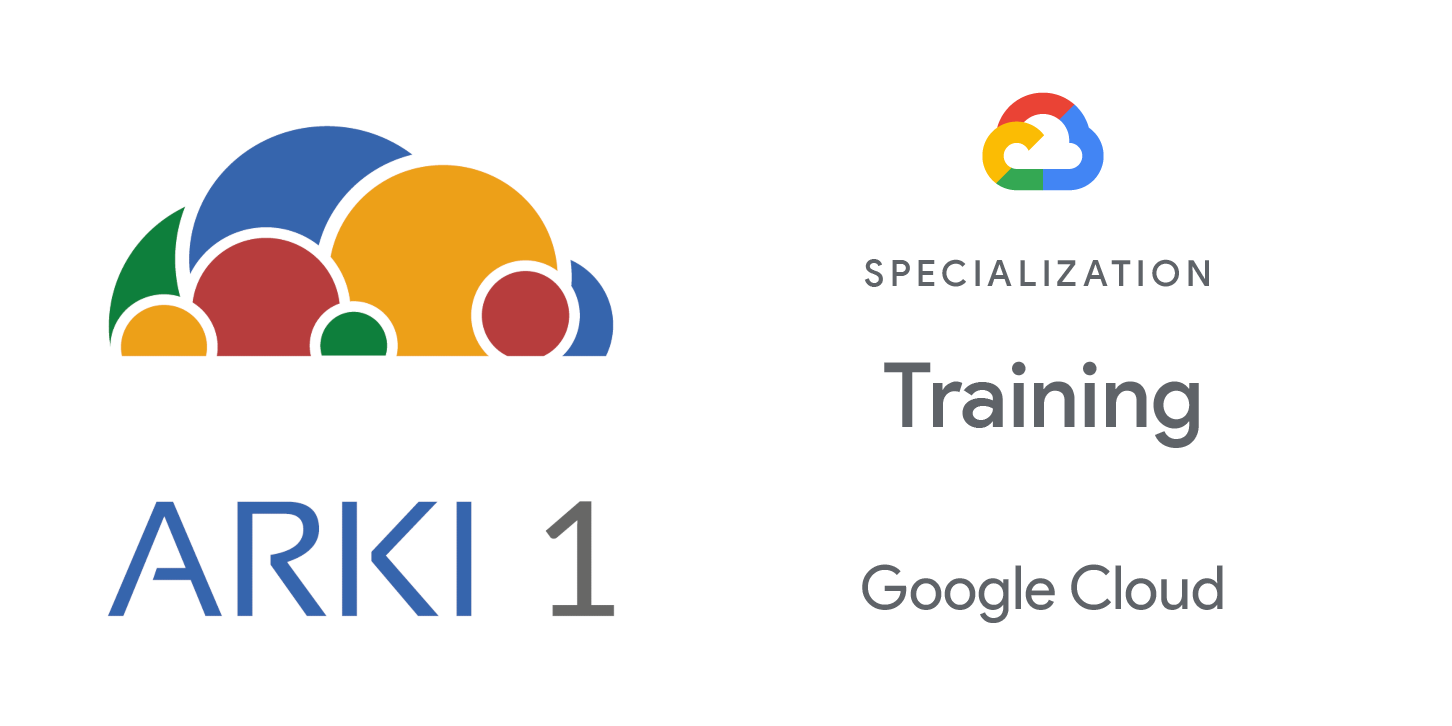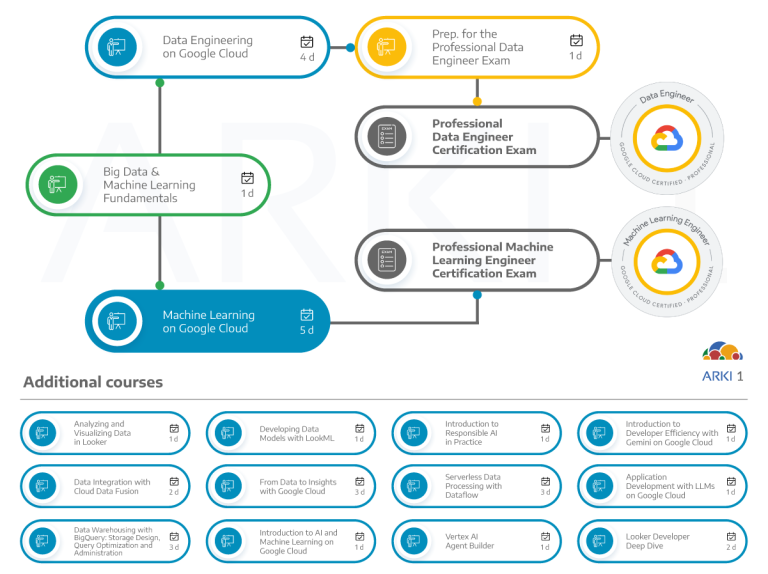Este curso te enseña a construir modelos de Vertex AI AutoML sin escribir una sola línea de código; crear modelos con BigQuery ML con conocimientos básicos de SQL; configurar trabajos de entrenamiento personalizados en Vertex AI usando contenedores (con poco conocimiento de Docker); utilizar Feature Store para la gestión y gobernanza de datos; aplicar ingeniería de características para mejorar los modelos; seleccionar las opciones adecuadas de preprocesamiento de datos para tu caso de uso; desarrollar modelos de aprendizaje automático distribuidos y escalables con TensorFlow; y aplicar las mejores prácticas para implementar soluciones de machine learning en Google Cloud. ¡Aprende todo esto y mucho más!
Objetivos
Este curso enseña a los participantes las siguientes habilidades:
• Crear, entrenar e implementar un modelo de aprendizaje automático sin escribir una sola línea de código usando Vertex AI AutoML.
• Entender cuándo usar AutoML y BigQuery ML.
• Crear conjuntos de datos gestionados en Vertex AI.
• Agregar características al Feature Store.
• Describir Analytics Hub, Dataplex y Data Catalog.
• Explicar el ajuste de hiperparámetros con Vertex Vizier y cómo puede mejorar el rendimiento del modelo.
• Crear un Notebook gestionado por el usuario en Vertex AI Workbench, construir un trabajo de entrenamiento personalizado e implementarlo usando un contenedor Docker.
• Describir predicciones por lotes (batch) y en línea (online), así como el monitoreo de modelos.
• Describir cómo mejorar la calidad de los datos.
• Realizar análisis exploratorio de datos.
• Construir y entrenar modelos de aprendizaje supervisado.
• Optimizar y evaluar modelos utilizando funciones de pérdida y métricas de rendimiento.
• Crear datasets de entrenamiento, validación y prueba escalables y reproducibles.
• Implementar modelos de ML con TensorFlow/Keras.
• Explicar cómo representar y transformar características.
• Comprender los beneficios de la ingeniería de características.
• Explicar Vertex AI Pipelines.
Público
Esta clase está dirigida a la siguiente audiencia:
- Personas aspirantes a analistas de datos, científicos de datos e ingenieros de datos en machine learning.
- Estudiantes o profesionales que buscan familiarizarse con ML usando Vertex AI AutoML, BQML, Feature Store, Workbench, Dataflow, Vizier (para ajuste de hiperparámetros) y TensorFlow/Keras.
Prerrequisitos
Para aprovechar al máximo este curso, los participantes deben cumplir con los siguientes criterios:
- Estar familiarizados con los conceptos básicos del aprendizaje automático.
- Tener conocimientos básicos sobre lenguajes de programación, de preferencia Python.
Duración
Inversión
Resumen del curso
What are best practices for implementing machine learning on Google Cloud? What is
Vertex AI and how can you use the platform to quickly build, train, and deploy AutoML
machine learning models without writing a single line of code? What is machine
learning, and what kinds of problems can it solve?
Google thinks about machine learning slightly differently: it’s about providing a unified
platform for managed datasets, a feature store, a way to build, train, and deploy
machine learning models without writing a single line of code, providing the ability
to label data, create Workbench notebooks using frameworks such as TensorFlow,
SciKit Learn, Pytorch, R, and others. Our Vertex AI Platform also includes the ability
to train custom models, build component pipelines, and perform both online and batch
predictions. We also discuss the five phases of converting a candidate use case to be
driven by machine learning, and consider why it is important to not skip the phases. We
end with a recognition of the biases that machine learning can amplify and how
to recognize them.
• Describe the Vertex AI Platform and how it is used to quickly build, train, and deploy
AutoML machine learning models without writing a single line of code.
• Describe best practices for implementing machine learning on Google Cloud.
• Develop a data strategy around machine learning.
• Examine use cases that are then reimagined through an ML lens.
• Leverage Google Cloud Platform tools and environment to do ML.
• Learn from Google’s experience to avoid common pitfalls.
• Carry out data science tasks in online collaborative notebooks.
The course begins with a discussion about data: how to improve data quality and
perform exploratory data analysis. We describe Vertex AI AutoML and how to build,
train, and deploy an ML model without writing a single line of code. You will understand
the benefits of Big Query ML. We then discuss how to optimize a machine learning
(ML) model and how generalization and sampling can help assess the quality of ML
models for custom training.
• Describe Vertex AI AutoML and how to build, train, and deploy an ML model without
writing a single line of code.
• Describe Big Query ML and its benefits.
• Describe how to improve data quality.
• Perform exploratory data analysis.
• Build and train supervised learning models.
• Optimize and evaluate models using loss functions and performance metrics.
• Mitigate common problems that arise in machine learning.
• Create repeatable and scalable training, evaluation, and test datasets.
The modules cover designing and building a TensorFlow input data pipeline, building
ML models with TensorFlow and Keras, improving the accuracy of ML models, writing
ML models for scaled use, and writing specialized ML models.
• Create TensorFlow and Keras machine learning models.
• Describe TensorFlow key components.
• Use the tf.data library to manipulate data and large datasets.
• Build a ML model using tf.keras preprocessing layers.
• Use the Keras Sequential and Functional APIs for simple and advanced model
creation. Understand how model subclassing can be used for more
customized models.
• Use tf.keras.preprocessing utilities for working with image data, text data, and
sequence data.
• Train, deploy, and productionalize ML models at scale with Cloud AI Platform.
Want to know about Vertex AI Feature Store? Want to know how you can improve
the accuracy of your ML models? What about how to find which data columns make
the most useful features? Welcome to Feature Engineering, where we discuss good
versus bad features and how you can preprocess and transform them for optimal use
in your models. This course includes content and labs on feature engineering using
BigQuery ML, Keras, and TensorFlow.
• Describe Vertex AI Feature Store.
• Compare the key required aspects of a good feature.
• Combine and create new feature combinations through feature crosses.
• Perform feature engineering using BigQuery ML, Keras, and TensorFlow.
• Understand how to preprocess and explore features with Dataflow and Dataprep
by Trifacta.
• Understand and apply how TensorFlow transforms features.
This course encompasses a real-world practical approach to the ML Workflow: a case
study approach that presents an ML team faced with several ML business
requirements and use cases. This team must understand the tools required for data
management and governance and consider the best approach for data preprocessing:
from providing an overview of Dataflow and Dataprep to using BigQuery
for preprocessing tasks.
The team is presented with three options to build machine learning models for two
specific use cases. This course explains why the team would use AutoML, BigQuery
ML, or custom training to achieve their objectives.
A deeper dive into custom training is presented in this course. We describe custom
training requirements from training code structure, storage, and loading large datasets
to exporting a trained model.
You will build a custom training machine learning model, which allows you to build
a container image with little knowledge of Docker.
The case study team examines hyperparameter tuning using Vertex Vizier and how it
can be used to improve model performance. To understand more about model
improvement, we dive into a bit of theory: we discuss regularization, dealing with
sparsity, and many other essential concepts and principles. We end with an overview
of prediction and model monitoring and how Vertex AI can be used to manage
ML models.
• Understand the tools required for data management and governance.
• Describe the best approach for data preprocessing: from providing an overview of
Dataflow and Dataprep to using SQL for preprocessing tasks.
• Explain how AutoML, BigQuery ML, and custom training differ and when to use
a particular framework.
• Describe hyperparameter tuning using Vertex Vizier and how it can be used
to improve model performance.
• Explain prediction and model monitoring and how Vertex AI can be used to manage
ML models.
• Describe the benefits of Vertex AI Pipelines.


